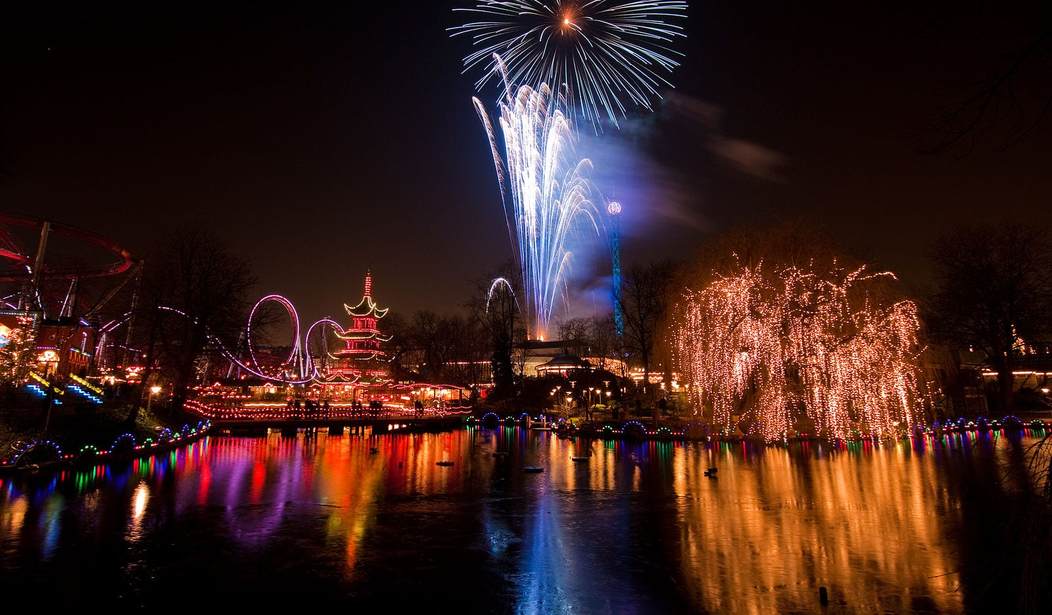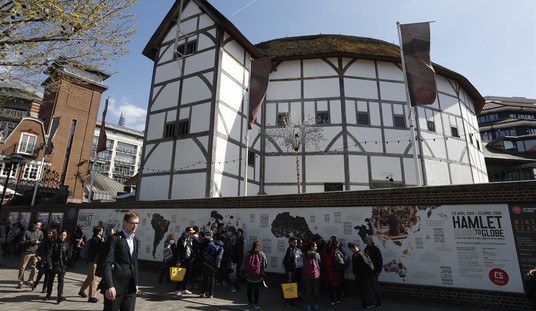Smack dab in the center of Copenhagen is an amusement park called Tivoli. First opened in 1843, it’s a special place. I always found Disneyland agitating, garish, and strangely disturbing – big and sprawling and fake and always insanely crowded, not just an amusement park but something more like a would-be alternate reality where you’re condemned to the hell of spending eternity queued up for some two-minute diversion surrounded by shrieking, ill-mannered children. (I’ve so far managed to avoid visiting Disney World.)
Tivoli’s not like that. It’s like a Japanese garden, modest and charming and meticulously put together. There’s a perfect mix of outdoor bars and cafes and fine eateries – a steak place here, a seafood place there, and charming restaurants with different architectures and atmospheres offering, variously, Spanish and Italian and German and Danish cuisine. There are rides for kids and rides for adults. There’s an arcade where you can throw a ball and knock things over and win outsized teddy bears and giant chocolate bars. There’s the smell of cotton candy and popcorn.
There’s a tree-shaded pond that’s lit up at night by multicolored bulbs You can have a world-class Wienerschnitzel with horseradish and baked carrots at a sumptuous restaurant overlooking the pond, then walk a few steps down a path and see a mother duck, on the small strip of grass between the path and pond, sleeping peacefully with her ducklings. You can put a five-kroner piece in a little machine by the pond and buy food to feed the fish in the pond. It’s sweet, not spectacular – compact and low-key, like Denmark itself. I’m exceedingly fond of it, and so are the Danes, for whom it’s nothing less than a national symbol not unlike the Eiffel Tower in France, the Colosseum in Italy, and Big Ben in Britain.
The travel writer Jan Morris doesn’t approve of Tivoli’s key role in the Danish psyche, saying that she finds it “childishly demeaning” that such a frivolous place “should stand at the very center of Denmark’s life and reputation.” That opinion appears in Morris’s 1997 book Fifty Years of Europe, and I remembered it when I first visited Tivoli many years ago. After experiencing the park for myself, I thought her criticism was unfair: for me, Tivoli seemed the perfect national symbol for a small, flat, pretty country inhabited by quiet, decent, pretty people who ride bicycles to work, whose most famous invention is Lego toys, and whose great author was a teller of children’s tales.
To be sure, even when I first visited Tivoli I knew there was a dark cloud over Hans Christian Andersen’s sunny little land. I had wandered through Nørrebro, the once-hip, Greenwich Village-type neighborhood of Copenhagen that was already becoming Islamized – this was in 2004 – and that will soon, I suspect, be a full-fledged no-go zone. (Copenhagen’s annual gay pride march used to go through Nørrebro; this year the organizers opted to re-route it, and insisted their decision had nothing to do with aggressive Muslim demands that the sodomites stay off “their” turf.)
It was also in 2004 that a Danish journalist said to me over dinner that her countrymen, in the wake of 9/11, still didn’t see Islam as a danger to themselves, and she feared that that wouldn’t change “until the terrorists blow up Tivoli.” In fact, when it comes to these matters Denmark has turned out to be more sensible than many other countries, at least in terms of its immigration and integration policies and the openness with which Islam can be discussed in the media. To drive across the Øresund Bridge from Copenhagen to Malmö, Sweden, is to travel from a country that may still have a fighting chance to one that is obviously teetering on the edge of self-destruction.
Yet in some regards Denmark has been as much of a disappointment as any. The third person who was at the above-mentioned dinner in 2004, Lars Hedegaard, would go on to be convicted of hate speech seven years later for a factual remark about Islam that he had made during a private conversation in his own home (the Supreme Court later reversed the verdict); still later, he would survive an assassination attempt by a jihadist only to be fined for publicly naming his attacker. Meanwhile, Denmark’s second city, Aarhus, is giving returning ISIS members free homes, and Copenhagen itself has been undergoing a wave of Muslim gang violence so extreme that the police, still trained to deal with relatively civilized Scandinavian offenders, have no clue how to handle it. All of which is to say that, just as is the case with every other country in Western Europe, there’s something terribly rotten in the state of Denmark.
But you’d never know it while visiting Tivoli. The terrorists still haven’t blown it up. It’s still a fairyland. Somehow it feels lighter than air. You’d think that Danish authorities would consider it a prime target, but I was surprised, on entering it this summer – only a couple of days, as it happened, before the jihadist attack on La Rambla in Barcelona – at the absence of any security measures at the front gate. (Similarly, while living in Oslo, I used to marvel at the vulnerability of the government buildings that ended up being damaged by Anders Breivik’s car bomb on July 22, 2011.)
I enjoyed my latest visit to Tivoli, but while I was there I thought constantly about the possibility that today just might be Denmark’s turn. In that regard, I felt pretty much alone. As far as I could tell, all the other customers that day – half Danes, half foreign tourists – were utterly carefree; the possibility of a terrorist attack appeared to be the furthest thing from their minds. One of them, an immensely tall, muscular, broad-shouldered, bald-headed Dane of about fifty – a guy who looked as if he could beat a hippo to death with his bare fists – was wearing a t-shirt that read, in English: Stop thinking and just let things happen. Somehow it seemed a fitting motto for a people who are still going through the motions of normality in the midst of a war for civilization.









Join the conversation as a VIP Member